
archgw
The smart edge and AI gateway for agents. Arch is a high-performance proxy server that handles the low-level work in building agents: like applying guardrails, routing prompts to the right agent, and unifying access to LLMs, etc. Natively designed to process prompts, it's framework-agnostic and helps you build agents faster.
Stars: 3637
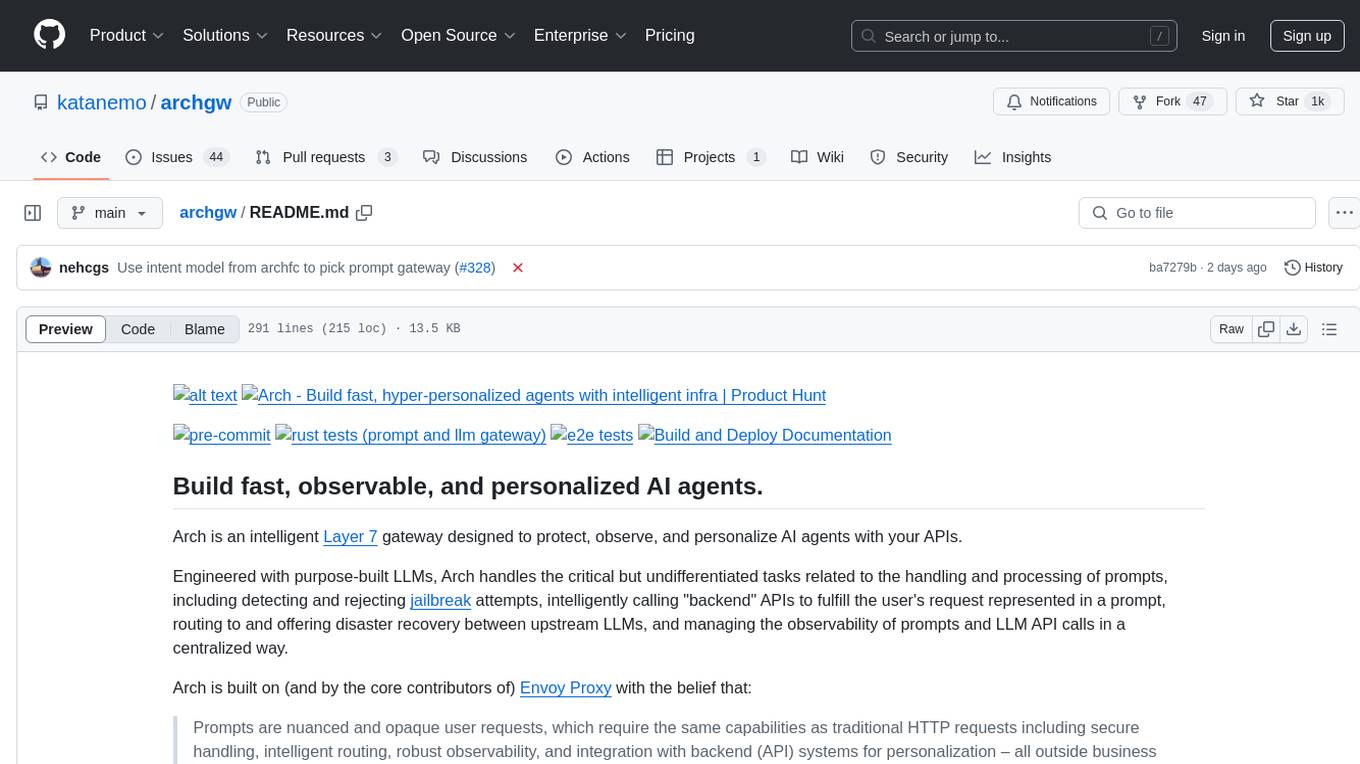
Arch is an intelligent Layer 7 gateway designed to protect, observe, and personalize AI agents with APIs. It handles tasks related to prompts, including detecting jailbreak attempts, calling backend APIs, routing between LLMs, and managing observability. Built on Envoy Proxy, it offers features like function calling, prompt guardrails, traffic management, and observability. Users can build fast, observable, and personalized AI agents using Arch to improve speed, security, and personalization of GenAI apps.
README:
Arch is a smart proxy server designed as a modular edge and AI gateway for agents.
Arch handles the pesky low-level work in building agentic apps — like applying guardrails, clarifying vague user input, routing prompts to the right agent, and unifying access to any LLM. It’s a language and framework friendly infrastructure layer designed to help you build and ship agentic apps faster.
Quickstart • Demos • Route LLMs • Build agentic apps with Arch • Documentation • Contact
AI demos are easy to hack. But once you move past a prototype, you’re stuck building and maintaining low-level plumbing code that slows down real innovation. For example:
- Routing & orchestration. Put routing in code and you’ve got two choices: maintain it yourself or live with a framework’s baked-in logic. Either way, keeping routing consistent means pushing code changes across all your agents, slowing iteration and turning every policy tweak into a refactor instead of a config flip.
- Model integration churn. Frameworks wire LLM integrations directly into code abstractions, making it hard to add or swap models without touching application code — meaning you’ll have to do codewide search/replace every time you want to experiment with a new model or version.
- Observability & governance. Logging, tracing, and guardrails are baked in as tightly coupled features, so bringing in best-of-breed solutions is painful and often requires digging through the guts of a framework.
- Prompt engineering overhead. Input validation, clarifying vague user input, and coercing outputs into the right schema all pile up, turning what should be design work into low-level plumbing work.
- Brittle upgrades. Every change (new model, new guardrail, new trace format) means patching and redeploying application servers. Contrast that with bouncing a central proxy—one upgrade, instantly consistent everywhere.
With Arch, you can move faster by focusing on higher-level objectives in a language and framework agnostic way. Arch was built by the contributors of Envoy Proxy with the belief that:
Prompts are nuanced and opaque user requests, which require the same capabilities as traditional HTTP requests including secure handling, intelligent routing, robust observability, and integration with backend (API) systems to improve speed and accuracy for common agentic scenarios – all outside core application logic.*
Core Features:
-
🚦 Route to Agents: Engineered with purpose-built LLMs for fast (<100ms) agent routing and hand-off -
🔗 Route to LLMs: Unify access to LLMs with support for dynamic routing. Model aliases coming soon -
⛨ Guardrails: Centrally configure and prevent harmful outcomes and ensure safe user interactions -
⚡ Tools Use: For common agentic scenarios let Arch instantly clarify and convert prompts to tools/API calls -
🕵 Observability: W3C compatible request tracing and LLM metrics that instantly plugin with popular tools -
🧱 Built on Envoy: Arch runs alongside app servers as a containerized process, and builds on top of Envoy's proven HTTP management and scalability features to handle ingress and egress traffic related to prompts and LLMs.
Jump to our docs to learn how you can use Arch to improve the speed, security and personalization of your GenAI apps.
[!IMPORTANT] Today, the function calling LLM (Arch-Function) designed for the agentic and RAG scenarios is hosted free of charge in the US-central region. To offer consistent latencies and throughput, and to manage our expenses, we will enable access to the hosted version via developers keys soon, and give you the option to run that LLM locally. For more details see this issue #258
To get in touch with us, please join our discord server. We will be monitoring that actively and offering support there.
- Sample App: Weather Forecast Agent - A sample agentic weather forecasting app that highlights core function calling capabilities of Arch.
- Sample App: Network Operator Agent - A simple network device switch operator agent that can retrive device statistics and reboot them.
- User Case: Connecting to SaaS APIs - Connect 3rd party SaaS APIs to your agentic chat experience.
Follow this quickstart guide to use Arch as a router for local or hosted LLMs, including dynamic routing. Later in the section we will see how you can Arch to build highly capable agentic applications, and to provide e2e observability.
Before you begin, ensure you have the following:
- Docker System (v24)
- Docker compose (v2.29)
- Python (v3.13)
Arch's CLI allows you to manage and interact with the Arch gateway efficiently. To install the CLI, simply run the following command:
[!TIP] We recommend that developers create a new Python virtual environment to isolate dependencies before installing Arch. This ensures that archgw and its dependencies do not interfere with other packages on your system.
$ python3.12 -m venv venv
$ source venv/bin/activate # On Windows, use: venv\Scripts\activate
$ pip install archgw==0.3.10Arch supports two primary routing strategies for LLMs: model-based routing and preference-based routing.
Model-based routing allows you to configure static model names for routing. This is useful when you always want to use a specific model for certain tasks, or manually swap between models. Below an example configuration for model-based routing, and you can follow our usage guide on how to get working.
version: v0.1.0
listeners:
egress_traffic:
address: 0.0.0.0
port: 12000
message_format: openai
timeout: 30s
llm_providers:
- access_key: $OPENAI_API_KEY
model: openai/gpt-4o
default: true
- access_key: $MISTRAL_API_KEY
model: mistral/mistral-3b-latestPreference-based routing is designed for more dynamic and intelligent selection of models. Instead of static model names, you write plain-language routing policies that describe the type of task or preference — for example:
version: v0.1.0
listeners:
egress_traffic:
address: 0.0.0.0
port: 12000
message_format: openai
timeout: 30s
llm_providers:
- model: openai/gpt-4.1
access_key: $OPENAI_API_KEY
default: true
routing_preferences:
- name: code generation
description: generating new code snippets, functions, or boilerplate based on user prompts or requirements
- model: openai/gpt-4o-mini
access_key: $OPENAI_API_KEY
routing_preferences:
- name: code understanding
description: understand and explain existing code snippets, functions, or librariesArch uses a lightweight 1.5B autoregressive model to map prompts (and conversation context) to these policies. This approach adapts to intent drift, supports multi-turn conversations, and avoids the brittleness of embedding-based classifiers or manual if/else chains. No retraining is required when adding new models or updating policies — routing is governed entirely by human-readable rules. You can learn more about the design, benchmarks, and methodology behind preference-based routing in our paper:
In following quickstart we will show you how easy it is to build AI agent with Arch gateway. We will build a currency exchange agent using following simple steps. For this demo we will use https://api.frankfurter.dev/ to fetch latest price for currencies and assume USD as base currency.
Create arch_config.yaml file with following content,
version: v0.1.0
listeners:
ingress_traffic:
address: 0.0.0.0
port: 10000
message_format: openai
timeout: 30s
llm_providers:
- access_key: $OPENAI_API_KEY
model: openai/gpt-4o
system_prompt: |
You are a helpful assistant.
prompt_guards:
input_guards:
jailbreak:
on_exception:
message: Looks like you're curious about my abilities, but I can only provide assistance for currency exchange.
prompt_targets:
- name: currency_exchange
description: Get currency exchange rate from USD to other currencies
parameters:
- name: currency_symbol
description: the currency that needs conversion
required: true
type: str
in_path: true
endpoint:
name: frankfurther_api
path: /v1/latest?base=USD&symbols={currency_symbol}
system_prompt: |
You are a helpful assistant. Show me the currency symbol you want to convert from USD.
- name: get_supported_currencies
description: Get list of supported currencies for conversion
endpoint:
name: frankfurther_api
path: /v1/currencies
endpoints:
frankfurther_api:
endpoint: api.frankfurter.dev:443
protocol: https$ archgw up arch_config.yaml
2024-12-05 16:56:27,979 - cli.main - INFO - Starting archgw cli version: 0.3.10
2024-12-05 16:56:28,485 - cli.utils - INFO - Schema validation successful!
2024-12-05 16:56:28,485 - cli.main - INFO - Starting arch model server and arch gateway
2024-12-05 16:56:51,647 - cli.core - INFO - Container is healthy!Once the gateway is up you can start interacting with at port 10000 using openai chat completion API.
Some of the sample queries you can ask could be what is currency rate for gbp? or show me list of currencies for conversion.
Here is a sample curl command you can use to interact,
$ curl --header 'Content-Type: application/json' \
--data '{"messages": [{"role": "user","content": "what is exchange rate for gbp"}], "model": "none"}' \
http://localhost:10000/v1/chat/completions | jq ".choices[0].message.content"
"As of the date provided in your context, December 5, 2024, the exchange rate for GBP (British Pound) from USD (United States Dollar) is 0.78558. This means that 1 USD is equivalent to 0.78558 GBP."
And to get list of supported currencies,
$ curl --header 'Content-Type: application/json' \
--data '{"messages": [{"role": "user","content": "show me list of currencies that are supported for conversion"}], "model": "none"}' \
http://localhost:10000/v1/chat/completions | jq ".choices[0].message.content"
"Here is a list of the currencies that are supported for conversion from USD, along with their symbols:\n\n1. AUD - Australian Dollar\n2. BGN - Bulgarian Lev\n3. BRL - Brazilian Real\n4. CAD - Canadian Dollar\n5. CHF - Swiss Franc\n6. CNY - Chinese Renminbi Yuan\n7. CZK - Czech Koruna\n8. DKK - Danish Krone\n9. EUR - Euro\n10. GBP - British Pound\n11. HKD - Hong Kong Dollar\n12. HUF - Hungarian Forint\n13. IDR - Indonesian Rupiah\n14. ILS - Israeli New Sheqel\n15. INR - Indian Rupee\n16. ISK - Icelandic Króna\n17. JPY - Japanese Yen\n18. KRW - South Korean Won\n19. MXN - Mexican Peso\n20. MYR - Malaysian Ringgit\n21. NOK - Norwegian Krone\n22. NZD - New Zealand Dollar\n23. PHP - Philippine Peso\n24. PLN - Polish Złoty\n25. RON - Romanian Leu\n26. SEK - Swedish Krona\n27. SGD - Singapore Dollar\n28. THB - Thai Baht\n29. TRY - Turkish Lira\n30. USD - United States Dollar\n31. ZAR - South African Rand\n\nIf you want to convert USD to any of these currencies, you can select the one you are interested in."
Arch is designed to support best-in class observability by supporting open standards. Please read our docs on observability for more details on tracing, metrics, and logs. The screenshot below is from our integration with Signoz (among others)
When debugging issues / errors application logs and access logs provide key information to give you more context on whats going on with the system. Arch gateway runs in info log level and following is a typical output you could see in a typical interaction between developer and arch gateway,
$ archgw up --service archgw --foreground
...
[2025-03-26 18:32:01.350][26][info] prompt_gateway: on_http_request_body: sending request to model server
[2025-03-26 18:32:01.851][26][info] prompt_gateway: on_http_call_response: model server response received
[2025-03-26 18:32:01.852][26][info] prompt_gateway: on_http_call_response: dispatching api call to developer endpoint: weather_forecast_service, path: /weather, method: POST
[2025-03-26 18:32:01.882][26][info] prompt_gateway: on_http_call_response: developer api call response received: status code: 200
[2025-03-26 18:32:01.882][26][info] prompt_gateway: on_http_call_response: sending request to upstream llm
[2025-03-26 18:32:01.883][26][info] llm_gateway: on_http_request_body: provider: gpt-4o-mini, model requested: None, model selected: gpt-4o-mini
[2025-03-26 18:32:02.818][26][info] llm_gateway: on_http_response_body: time to first token: 1468ms
[2025-03-26 18:32:04.532][26][info] llm_gateway: on_http_response_body: request latency: 3183ms
...
Log level can be changed to debug to get more details. To enable debug logs edit (supervisord.conf)[arch/supervisord.conf], change the log level --component-log-level wasm:info to --component-log-level wasm:debug. And after that you need to rebuild docker image and restart the arch gateway using following set of commands,
# make sure you are at the root of the repo
$ archgw build
# go to your service that has arch_config.yaml file and issue following command,
$ archgw up --service archgw --foreground
We would love feedback on our Roadmap and we welcome contributions to Arch! Whether you're fixing bugs, adding new features, improving documentation, or creating tutorials, your help is much appreciated. Please visit our Contribution Guide for more details
For Tasks:
Click tags to check more tools for each tasksFor Jobs:
Alternative AI tools for archgw
Similar Open Source Tools

archgw
Arch is an intelligent Layer 7 gateway designed to protect, observe, and personalize AI agents with APIs. It handles tasks related to prompts, including detecting jailbreak attempts, calling backend APIs, routing between LLMs, and managing observability. Built on Envoy Proxy, it offers features like function calling, prompt guardrails, traffic management, and observability. Users can build fast, observable, and personalized AI agents using Arch to improve speed, security, and personalization of GenAI apps.
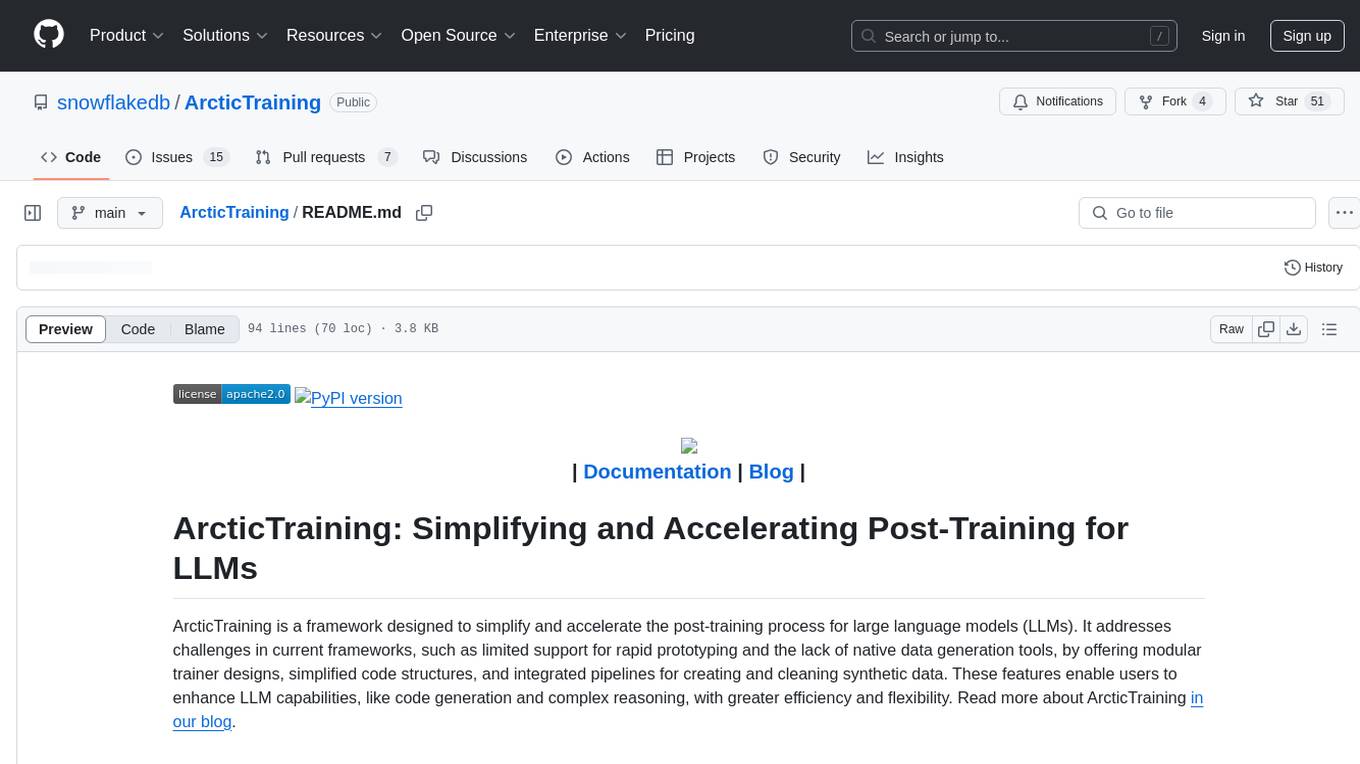
ArcticTraining
ArcticTraining is a framework designed to simplify and accelerate the post-training process for large language models (LLMs). It offers modular trainer designs, simplified code structures, and integrated pipelines for creating and cleaning synthetic data, enabling users to enhance LLM capabilities like code generation and complex reasoning with greater efficiency and flexibility.
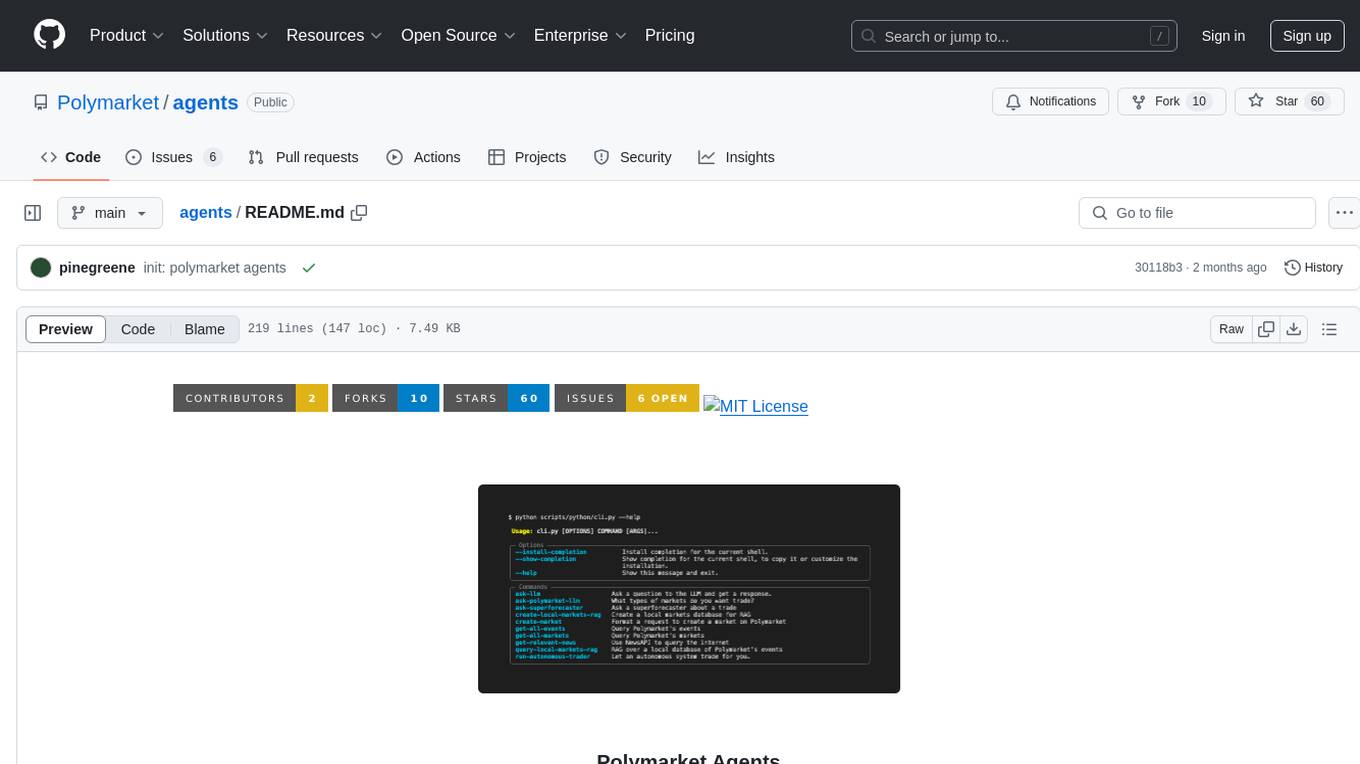
agents
Polymarket Agents is a developer framework and set of utilities for building AI agents to trade autonomously on Polymarket. It integrates with Polymarket API, provides AI agent utilities for prediction markets, supports local and remote RAG, sources data from various services, and offers comprehensive LLM tools for prompt engineering. The architecture features modular components like APIs and scripts for managing local environments, server set-up, and CLI for end-user commands.
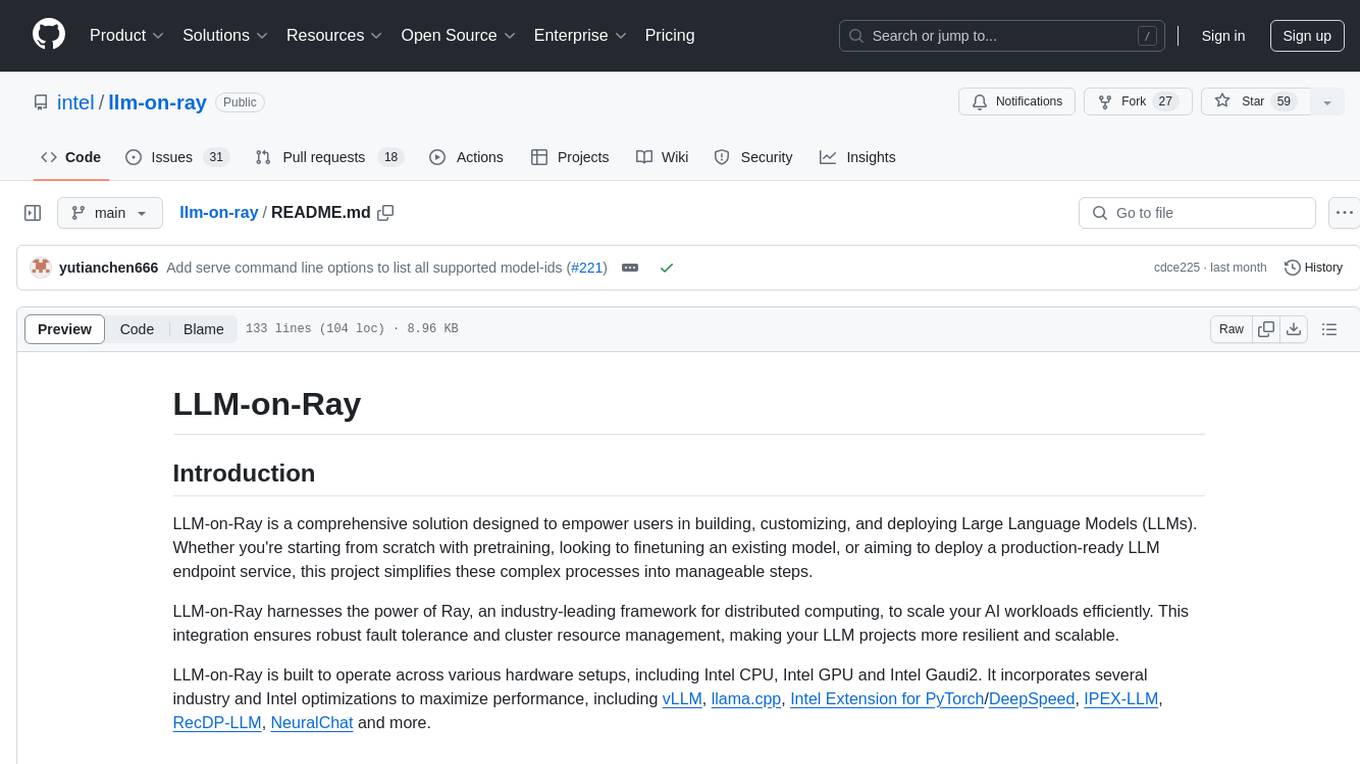
llm-on-ray
LLM-on-Ray is a comprehensive solution for building, customizing, and deploying Large Language Models (LLMs). It simplifies complex processes into manageable steps by leveraging the power of Ray for distributed computing. The tool supports pretraining, finetuning, and serving LLMs across various hardware setups, incorporating industry and Intel optimizations for performance. It offers modular workflows with intuitive configurations, robust fault tolerance, and scalability. Additionally, it provides an Interactive Web UI for enhanced usability, including a chatbot application for testing and refining models.
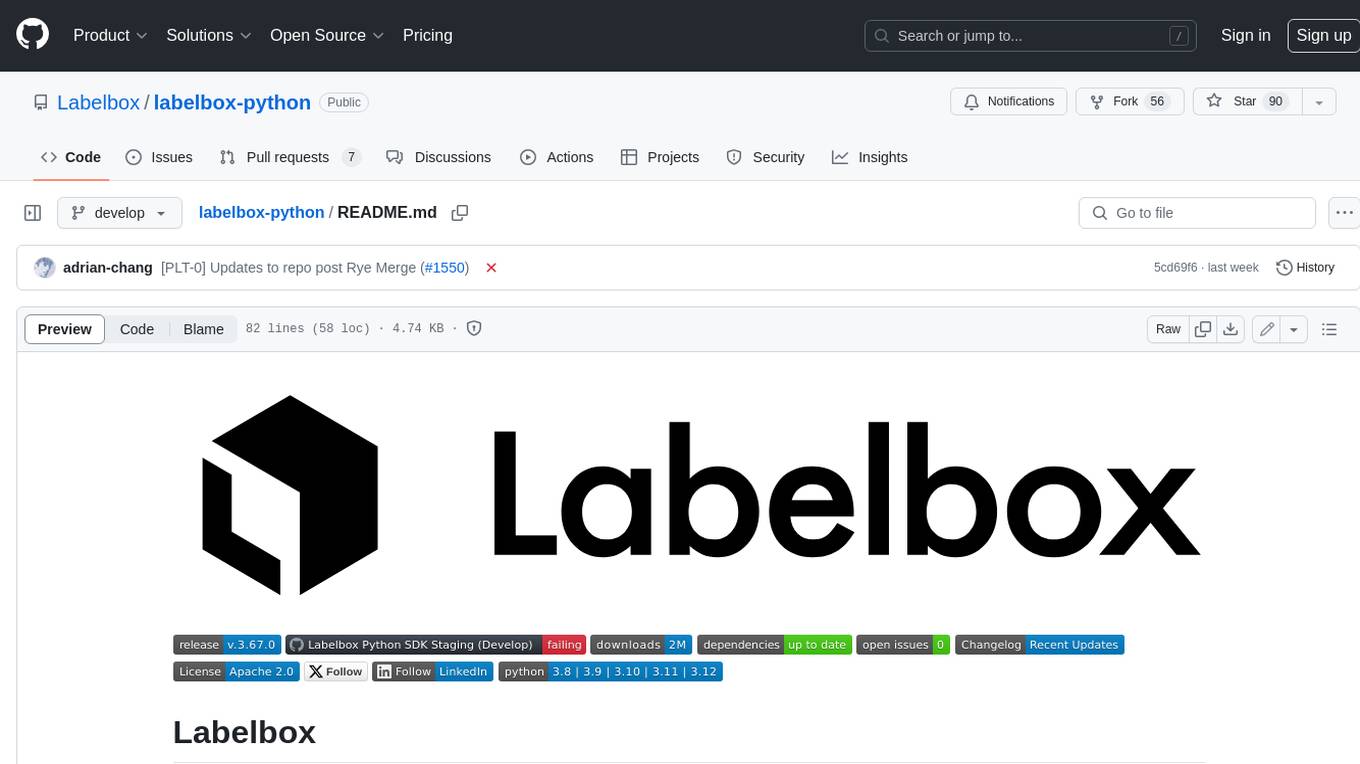
labelbox-python
Labelbox is a data-centric AI platform for enterprises to develop, optimize, and use AI to solve problems and power new products and services. Enterprises use Labelbox to curate data, generate high-quality human feedback data for computer vision and LLMs, evaluate model performance, and automate tasks by combining AI and human-centric workflows. The academic & research community uses Labelbox for cutting-edge AI research.
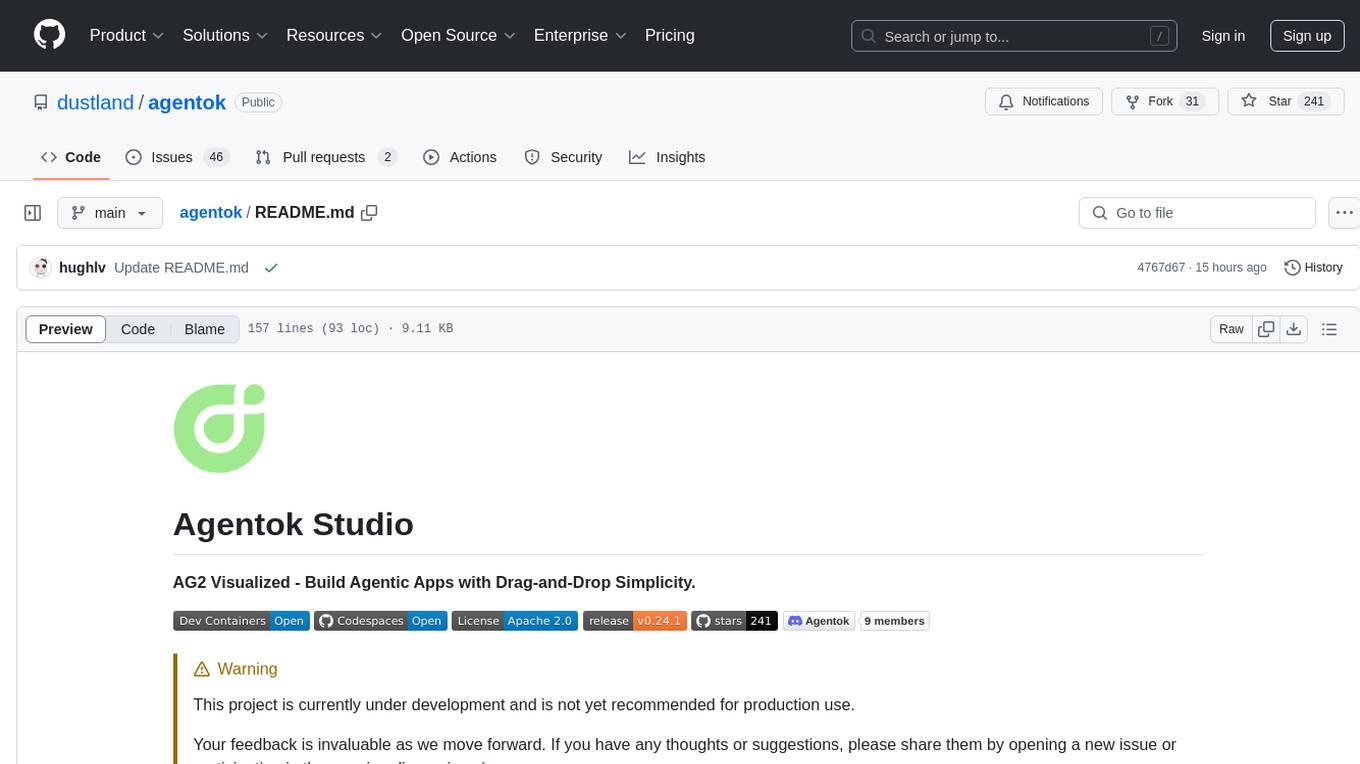
agentok
Agentok Studio is a tool built upon AG2, a powerful agent framework from Microsoft, offering intuitive visual tools to streamline the creation and management of complex agent-based workflows. It simplifies the process for creators and developers by generating native Python code with minimal dependencies, enabling users to create self-contained code that can be executed anywhere. The tool is currently under development and not recommended for production use, but contributions are welcome from the community to enhance its capabilities and functionalities.

kaito
KAITO is an operator that automates the AI/ML model inference or tuning workload in a Kubernetes cluster. It manages large model files using container images, provides preset configurations to avoid adjusting workload parameters based on GPU hardware, supports popular open-sourced inference runtimes, auto-provisions GPU nodes based on model requirements, and hosts large model images in the public Microsoft Container Registry. Using KAITO simplifies the workflow of onboarding large AI inference models in Kubernetes.
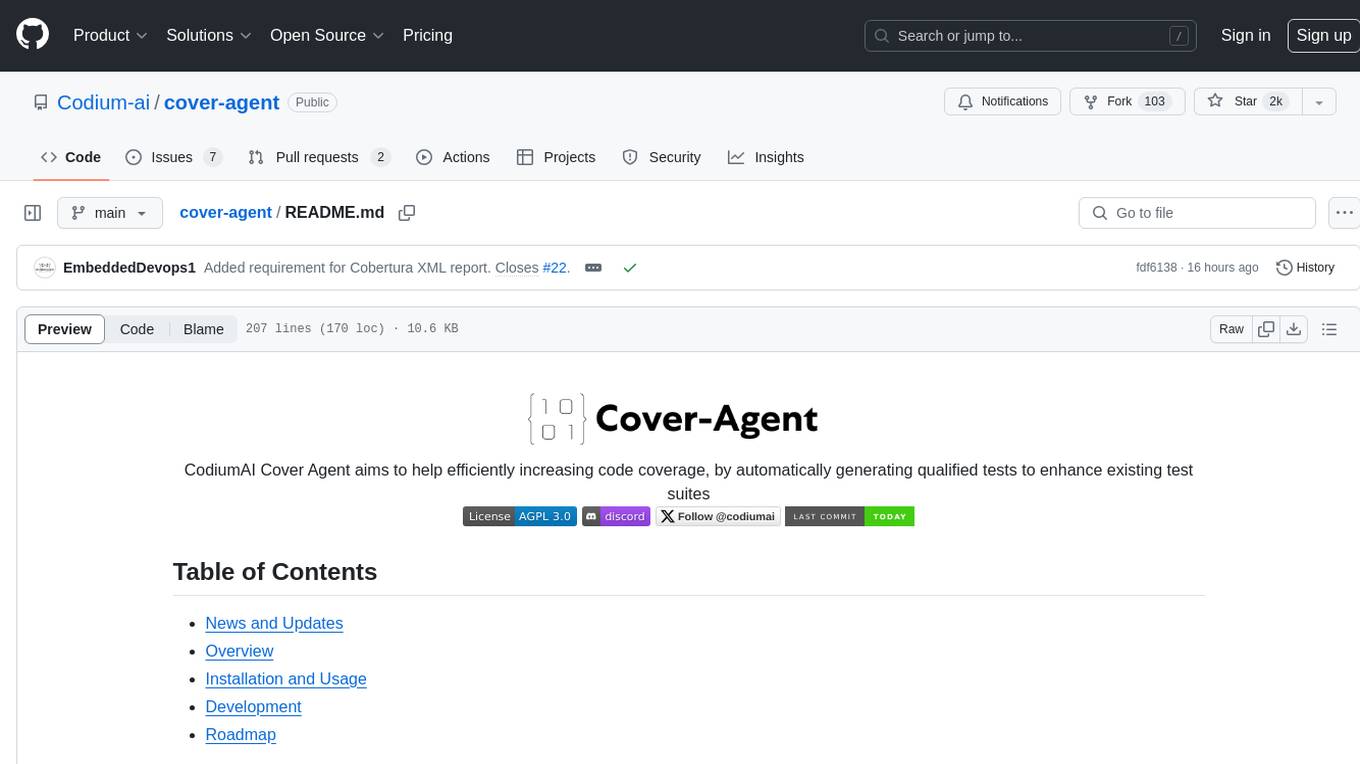
cover-agent
CodiumAI Cover Agent is a tool designed to help increase code coverage by automatically generating qualified tests to enhance existing test suites. It utilizes Generative AI to streamline development workflows and is part of a suite of utilities aimed at automating the creation of unit tests for software projects. The system includes components like Test Runner, Coverage Parser, Prompt Builder, and AI Caller to simplify and expedite the testing process, ensuring high-quality software development. Cover Agent can be run via a terminal and is planned to be integrated into popular CI platforms. The tool outputs debug files locally, such as generated_prompt.md, run.log, and test_results.html, providing detailed information on generated tests and their status. It supports multiple LLMs and allows users to specify the model to use for test generation.
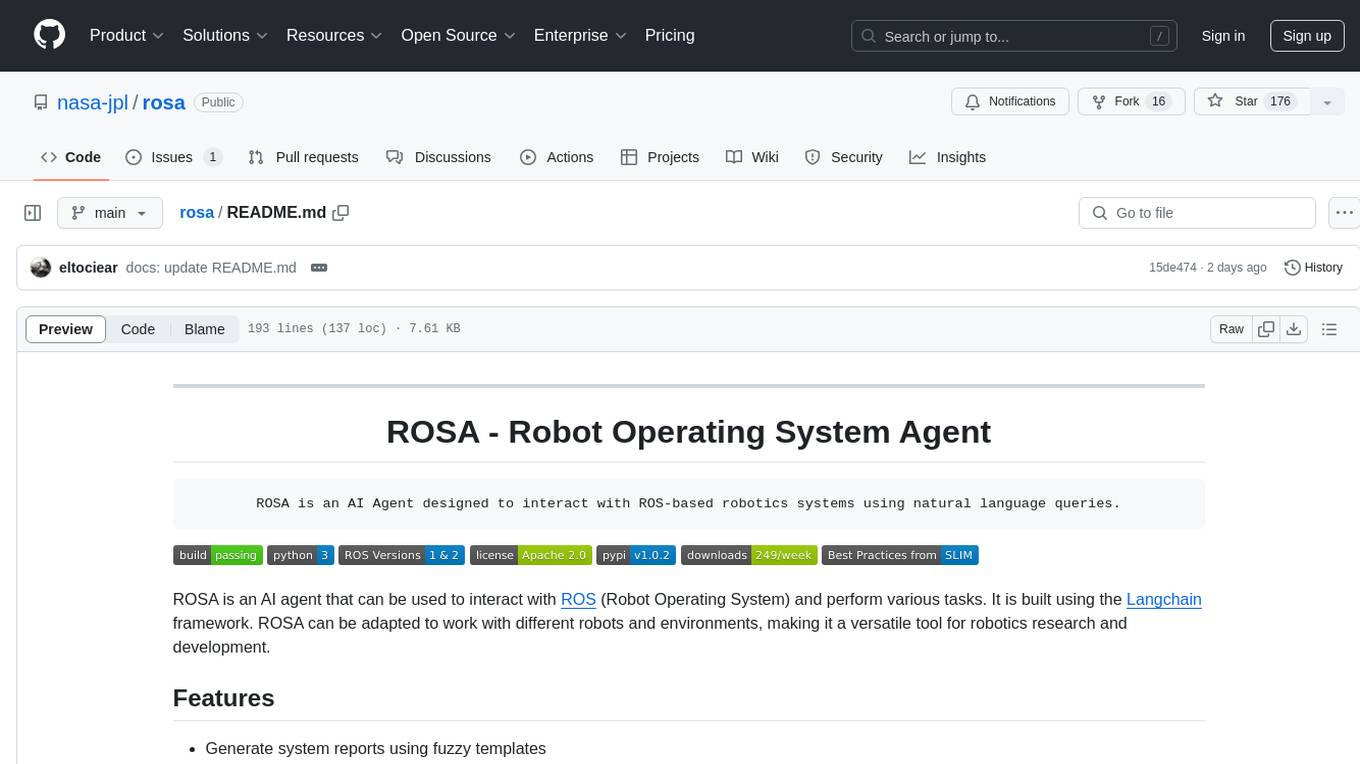
rosa
ROSA is an AI Agent designed to interact with ROS-based robotics systems using natural language queries. It can generate system reports, read and parse ROS log files, adapt to new robots, and run various ROS commands using natural language. The tool is versatile for robotics research and development, providing an easy way to interact with robots and the ROS environment.
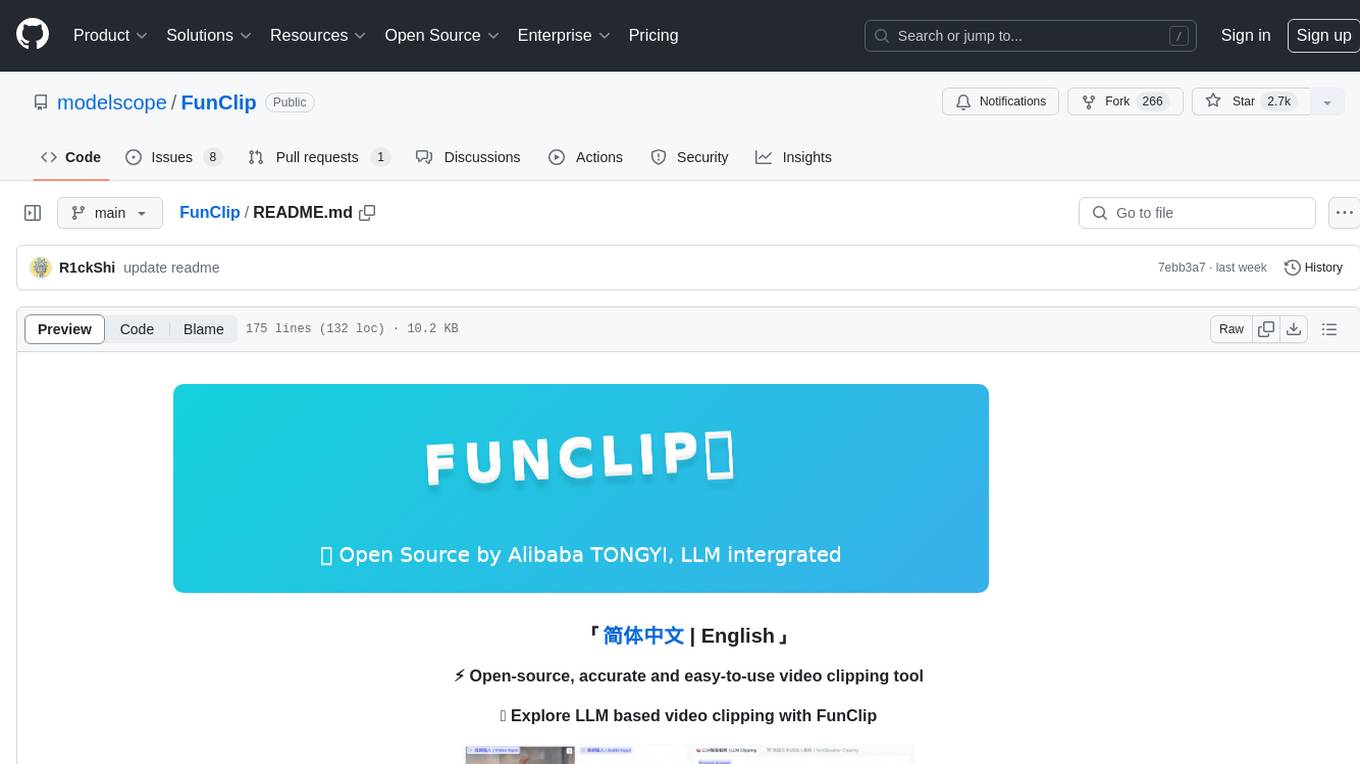
FunClip
FunClip is an open-source, locally deployed automated video clipping tool that leverages Alibaba TONGYI speech lab's FunASR Paraformer series models for speech recognition on videos. Users can select text segments or speakers from recognition results to obtain corresponding video clips. It integrates industrial-grade models for accurate predictions and offers hotword customization and speaker recognition features. The tool is user-friendly with Gradio interaction, supporting multi-segment clipping and providing full video and target segment subtitles. FunClip is suitable for users looking to automate video clipping tasks with advanced AI capabilities.
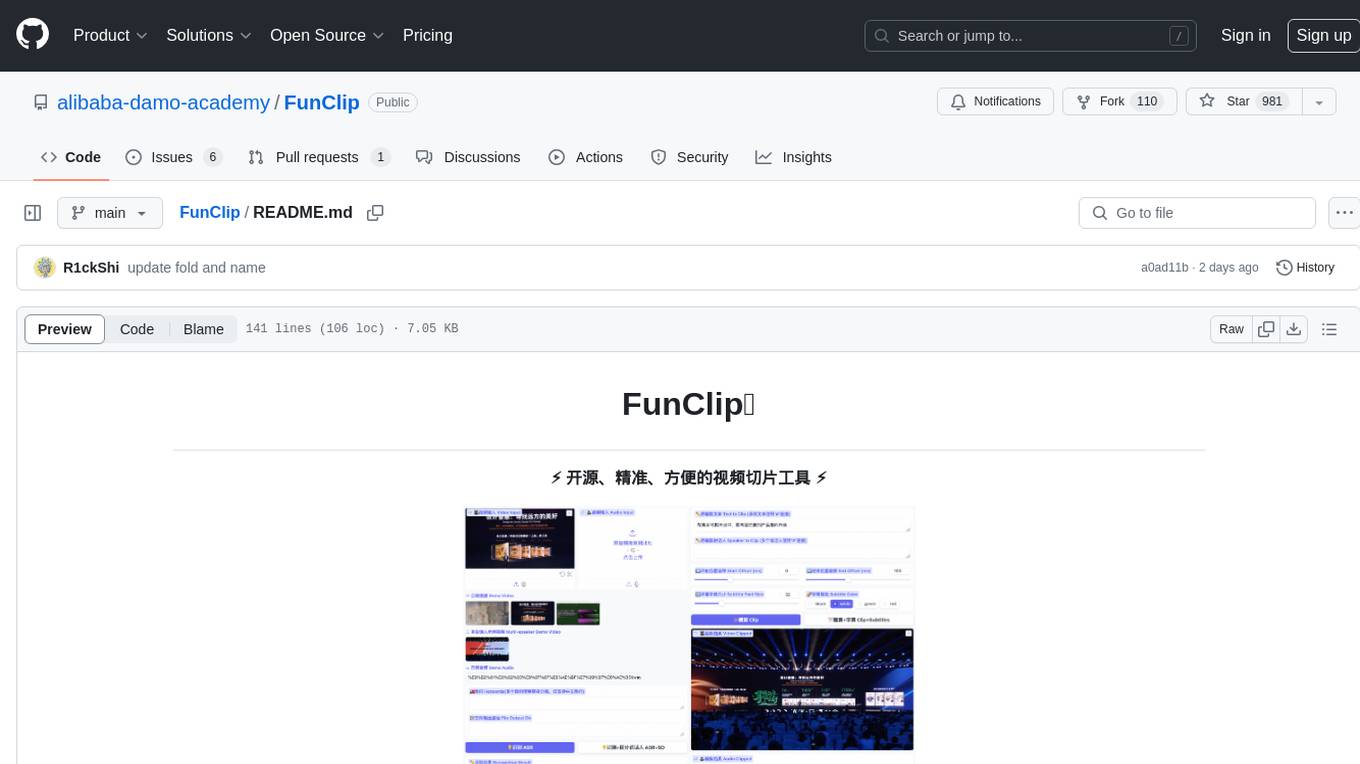
FunClip
FunClip is an open-source, locally deployable automated video editing tool that utilizes the FunASR Paraformer series models from Alibaba DAMO Academy for speech recognition in videos. Users can select text segments or speakers from the recognition results and click the clip button to obtain the corresponding video segments. FunClip integrates advanced features such as the Paraformer-Large model for accurate Chinese ASR, SeACo-Paraformer for customized hotword recognition, CAM++ speaker recognition model, Gradio interactive interface for easy usage, support for multiple free edits with automatic SRT subtitles generation, and segment-specific SRT subtitles.
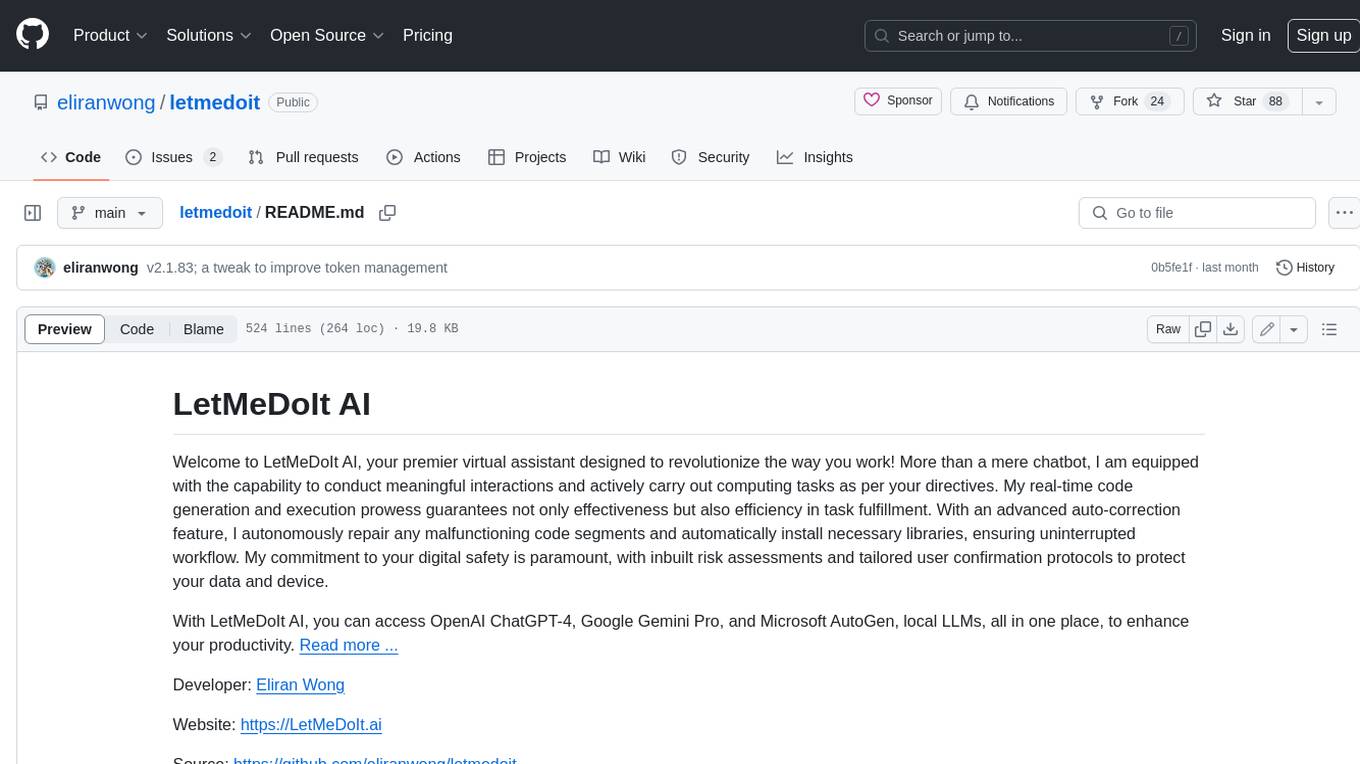
letmedoit
LetMeDoIt AI is a virtual assistant designed to revolutionize the way you work. It goes beyond being a mere chatbot by offering a unique and powerful capability - the ability to execute commands and perform computing tasks on your behalf. With LetMeDoIt AI, you can access OpenAI ChatGPT-4, Google Gemini Pro, and Microsoft AutoGen, local LLMs, all in one place, to enhance your productivity.
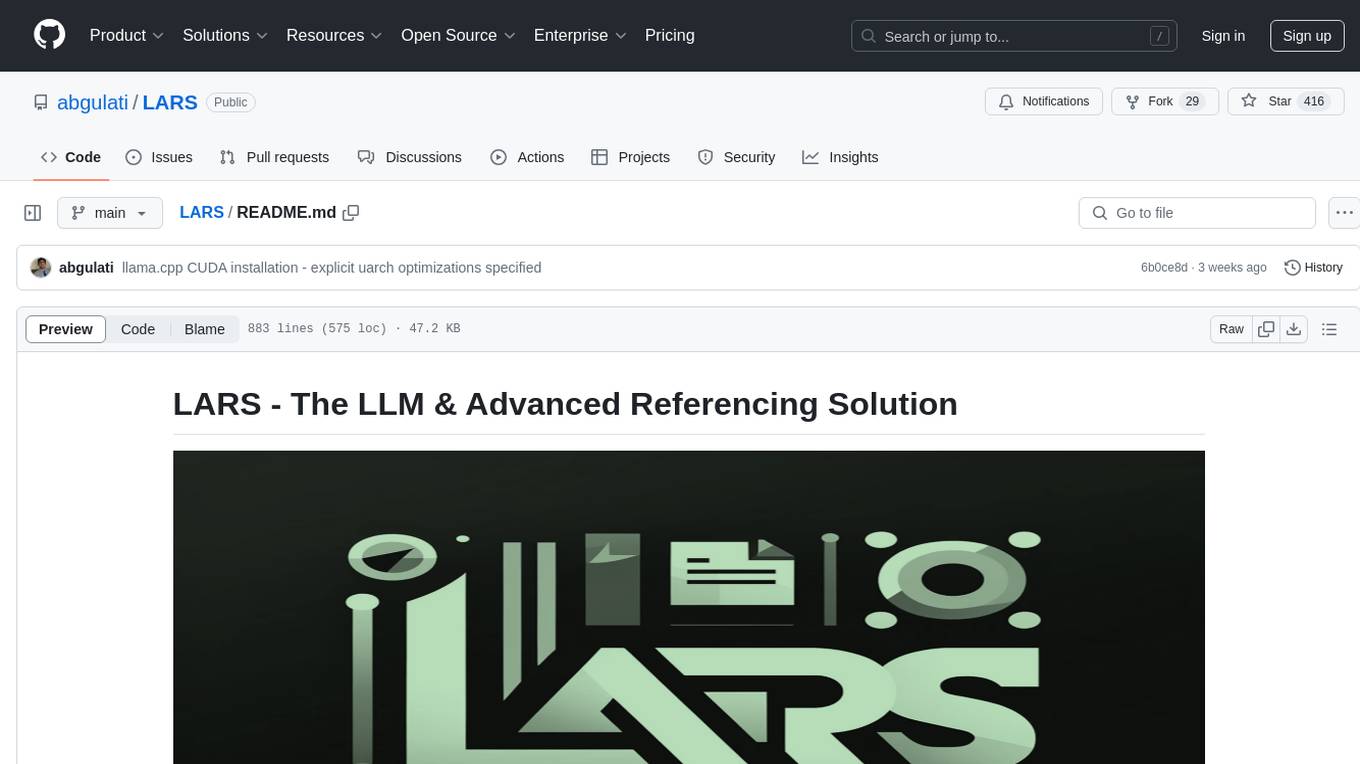
LARS
LARS is an application that enables users to run Large Language Models (LLMs) locally on their devices, upload their own documents, and engage in conversations where the LLM grounds its responses with the uploaded content. The application focuses on Retrieval Augmented Generation (RAG) to increase accuracy and reduce AI-generated inaccuracies. LARS provides advanced citations, supports various file formats, allows follow-up questions, provides full chat history, and offers customization options for LLM settings. Users can force enable or disable RAG, change system prompts, and tweak advanced LLM settings. The application also supports GPU-accelerated inferencing, multiple embedding models, and text extraction methods. LARS is open-source and aims to be the ultimate RAG-centric LLM application.
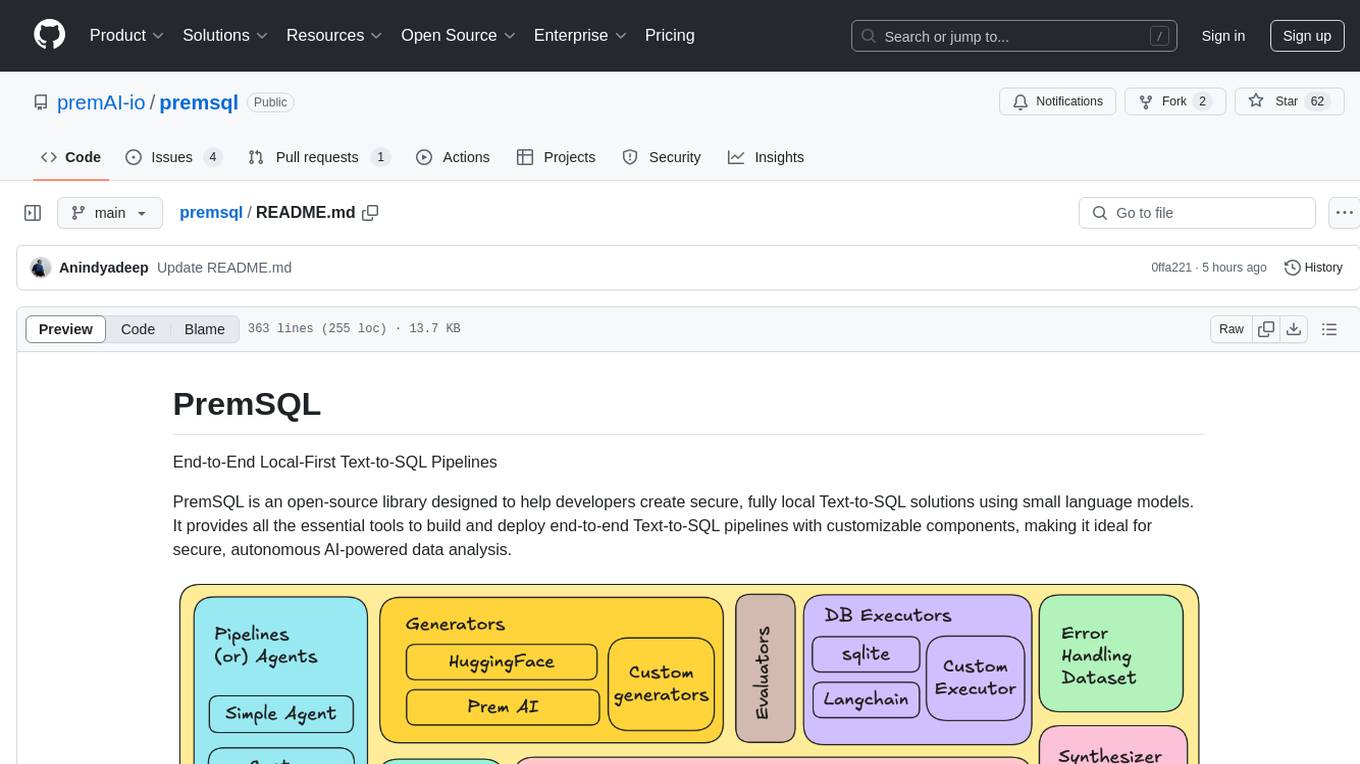
premsql
PremSQL is an open-source library designed to help developers create secure, fully local Text-to-SQL solutions using small language models. It provides essential tools for building and deploying end-to-end Text-to-SQL pipelines with customizable components, ideal for secure, autonomous AI-powered data analysis. The library offers features like Local-First approach, Customizable Datasets, Robust Executors and Evaluators, Advanced Generators, Error Handling and Self-Correction, Fine-Tuning Support, and End-to-End Pipelines. Users can fine-tune models, generate SQL queries from natural language inputs, handle errors, and evaluate model performance against predefined metrics. PremSQL is extendible for customization and private data usage.
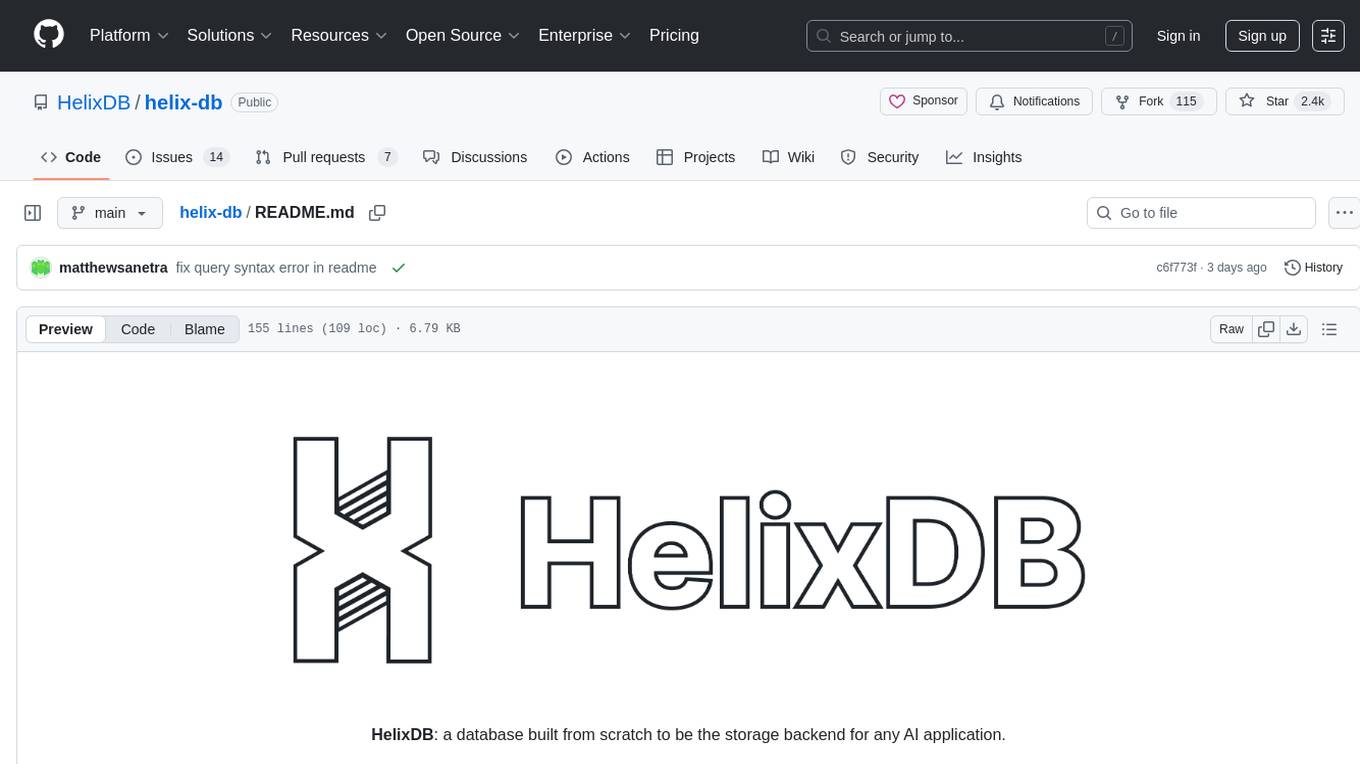
helix-db
HelixDB is a database designed specifically for AI applications, providing a single platform to manage all components needed for AI applications. It supports graph + vector data model and also KV, documents, and relational data. Key features include built-in tools for MCP, embeddings, knowledge graphs, RAG, security, logical isolation, and ultra-low latency. Users can interact with HelixDB using the Helix CLI tool and SDKs in TypeScript and Python. The roadmap includes features like organizational auth, server code improvements, 3rd party integrations, educational content, and binary quantisation for better performance. Long term projects involve developing in-house tools for knowledge graph ingestion, graph-vector storage engine, and network protocol & serdes libraries.

DemoGPT
DemoGPT is an all-in-one agent library that provides tools, prompts, frameworks, and LLM models for streamlined agent development. It leverages GPT-3.5-turbo to generate LangChain code, creating interactive Streamlit applications. The tool is designed for creating intelligent, interactive, and inclusive solutions in LLM-based application development. It offers model flexibility, iterative development, and a commitment to user engagement. Future enhancements include integrating Gorilla for autonomous API usage and adding a publicly available database for refining the generation process.
For similar tasks
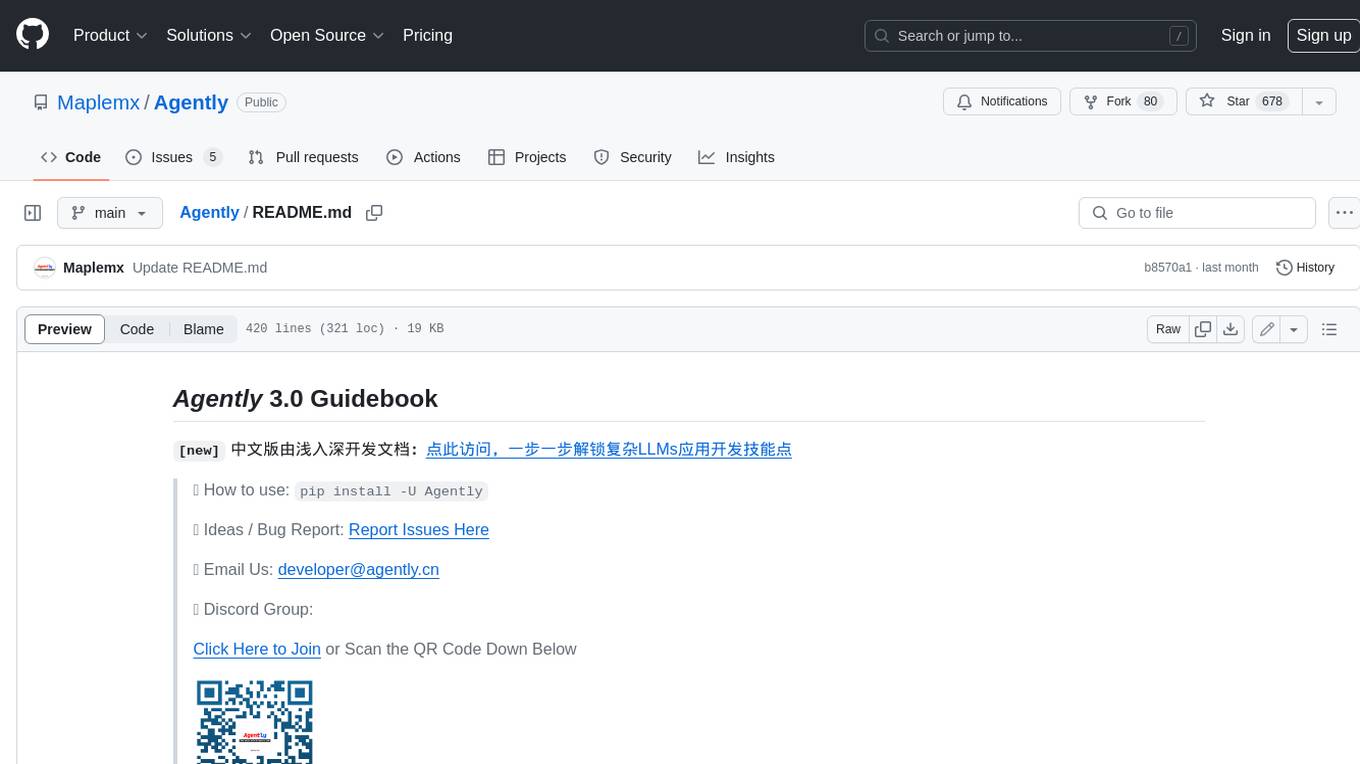
Agently
Agently is a development framework that helps developers build AI agent native application really fast. You can use and build AI agent in your code in an extremely simple way. You can create an AI agent instance then interact with it like calling a function in very few codes like this below. Click the run button below and witness the magic. It's just that simple: python # Import and Init Settings import Agently agent = Agently.create_agent() agent\ .set_settings("current_model", "OpenAI")\ .set_settings("model.OpenAI.auth", {"api_key": ""}) # Interact with the agent instance like calling a function result = agent\ .input("Give me 3 words")\ .output([("String", "one word")])\ .start() print(result) ['apple', 'banana', 'carrot'] And you may notice that when we print the value of `result`, the value is a `list` just like the format of parameter we put into the `.output()`. In Agently framework we've done a lot of work like this to make it easier for application developers to integrate Agent instances into their business code. This will allow application developers to focus on how to build their business logic instead of figure out how to cater to language models or how to keep models satisfied.
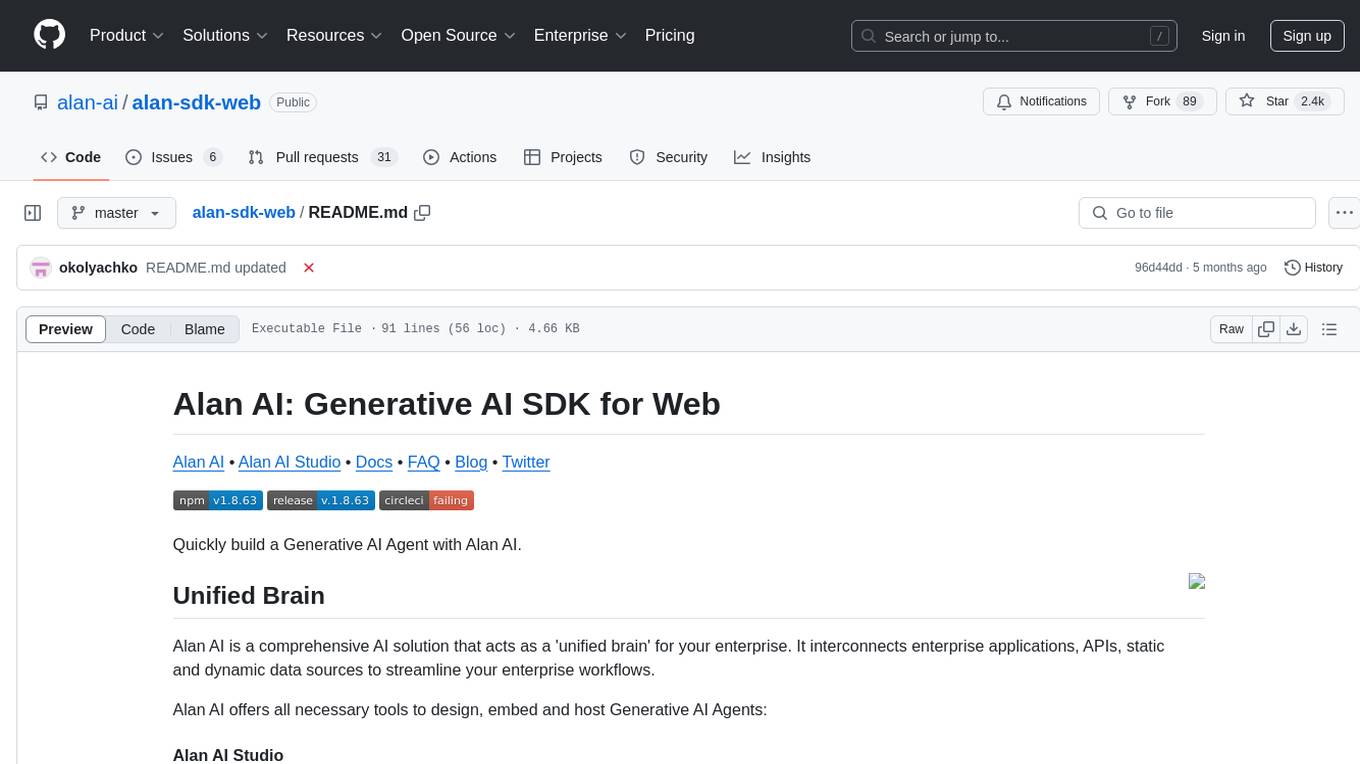
alan-sdk-web
Alan AI is a comprehensive AI solution that acts as a 'unified brain' for enterprises, interconnecting applications, APIs, and data sources to streamline workflows. It offers tools like Alan AI Studio for designing dialog scenarios, lightweight SDKs for embedding AI Agents, and a backend powered by advanced AI technologies. With Alan AI, users can create conversational experiences with minimal UI changes, benefit from a serverless environment, receive on-the-fly updates, and access dialog testing and analytics tools. The platform supports various frameworks like JavaScript, React, Angular, Vue, Ember, and Electron, and provides example web apps for different platforms. Users can also explore Alan AI SDKs for iOS, Android, Flutter, Ionic, Apache Cordova, and React Native.

archgw
Arch is an intelligent Layer 7 gateway designed to protect, observe, and personalize AI agents with APIs. It handles tasks related to prompts, including detecting jailbreak attempts, calling backend APIs, routing between LLMs, and managing observability. Built on Envoy Proxy, it offers features like function calling, prompt guardrails, traffic management, and observability. Users can build fast, observable, and personalized AI agents using Arch to improve speed, security, and personalization of GenAI apps.
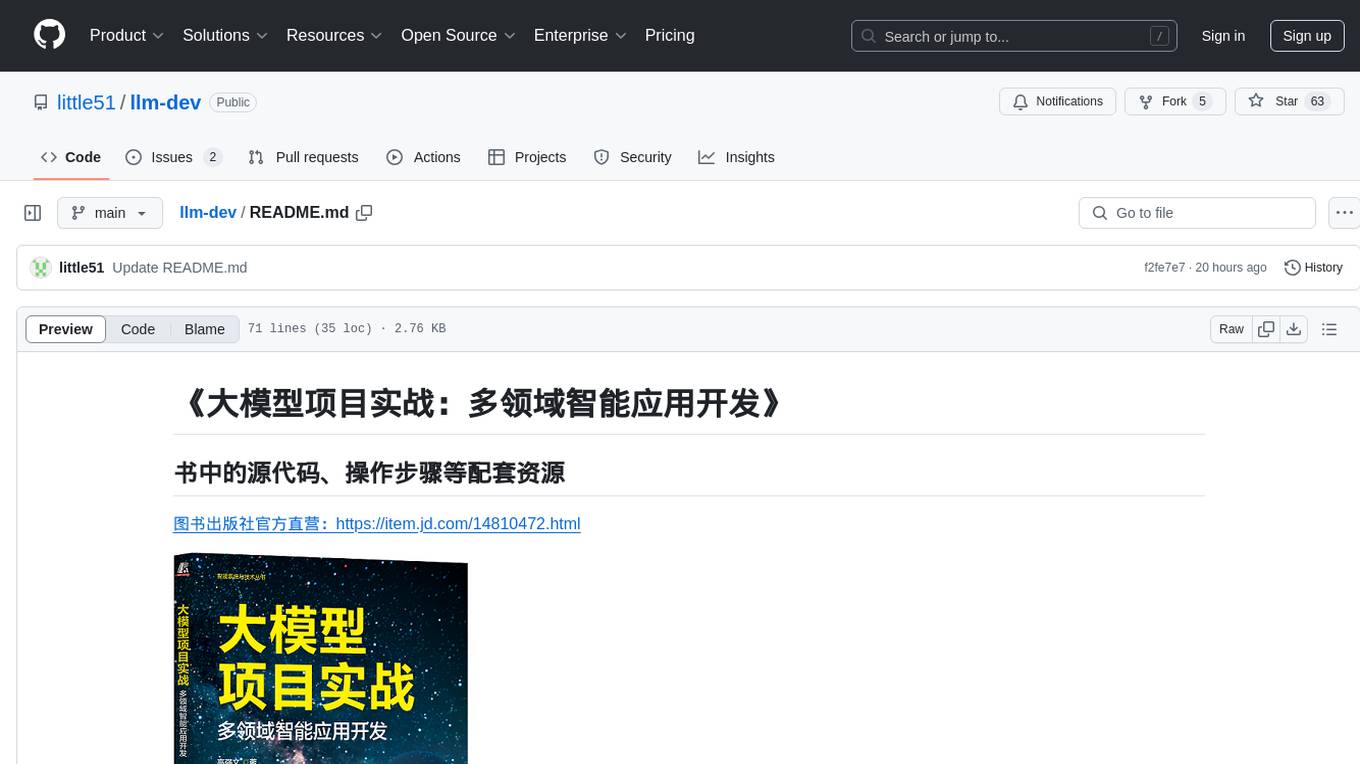
llm-dev
The 'llm-dev' repository contains source code and resources for the book 'Practical Projects of Large Models: Multi-Domain Intelligent Application Development'. It covers topics such as language model basics, application architecture, working modes, environment setup, model installation, fine-tuning, quantization, multi-modal model applications, chat applications, programming large model applications, VS Code plugin development, enhanced generation applications, translation applications, intelligent agent applications, speech model applications, digital human applications, model training applications, and AI town applications.

agent-starter-pack
The agent-starter-pack is a collection of production-ready Generative AI Agent templates built for Google Cloud. It accelerates development by providing a holistic, production-ready solution, addressing common challenges in building and deploying GenAI agents. The tool offers pre-built agent templates, evaluation tools, production-ready infrastructure, and customization options. It also provides CI/CD automation and data pipeline integration for RAG agents. The starter pack covers all aspects of agent development, from prototyping and evaluation to deployment and monitoring. It is designed to simplify project creation, template selection, and deployment for agent development on Google Cloud.

paig
PAIG is an open-source project focused on protecting Generative AI applications by ensuring security, safety, and observability. It offers a versatile framework to address the latest security challenges and integrate point security solutions without rewriting applications. The project aims to provide a secure environment for developing and deploying GenAI applications.
For similar jobs
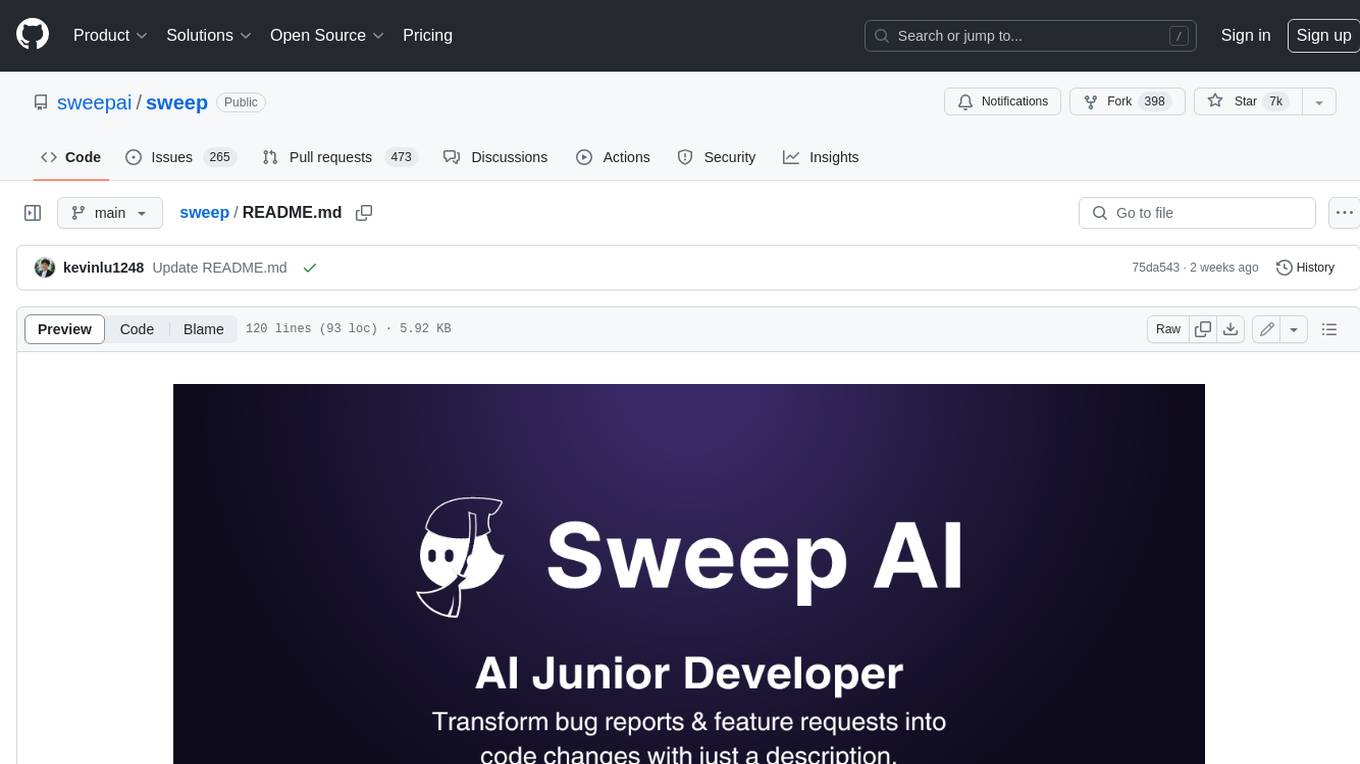
sweep
Sweep is an AI junior developer that turns bugs and feature requests into code changes. It automatically handles developer experience improvements like adding type hints and improving test coverage.
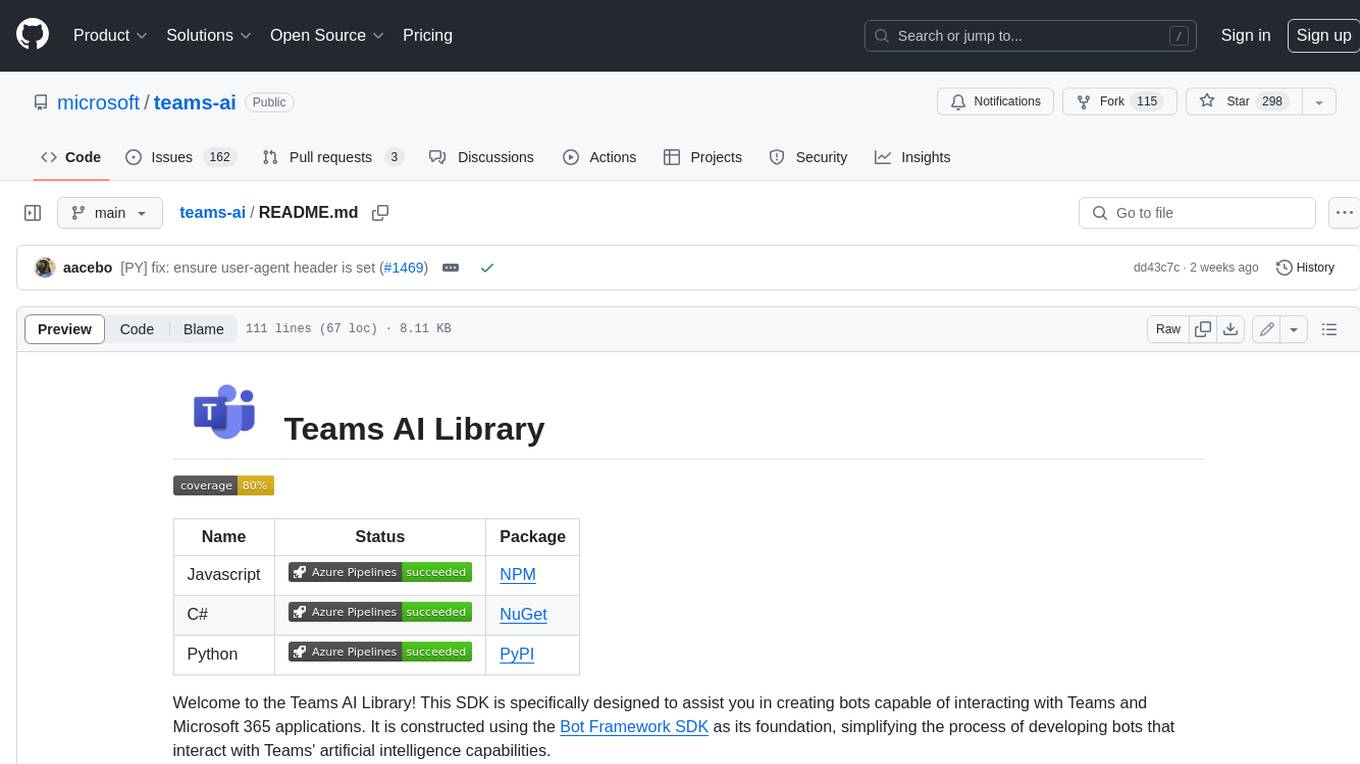
teams-ai
The Teams AI Library is a software development kit (SDK) that helps developers create bots that can interact with Teams and Microsoft 365 applications. It is built on top of the Bot Framework SDK and simplifies the process of developing bots that interact with Teams' artificial intelligence capabilities. The SDK is available for JavaScript/TypeScript, .NET, and Python.

ai-guide
This guide is dedicated to Large Language Models (LLMs) that you can run on your home computer. It assumes your PC is a lower-end, non-gaming setup.
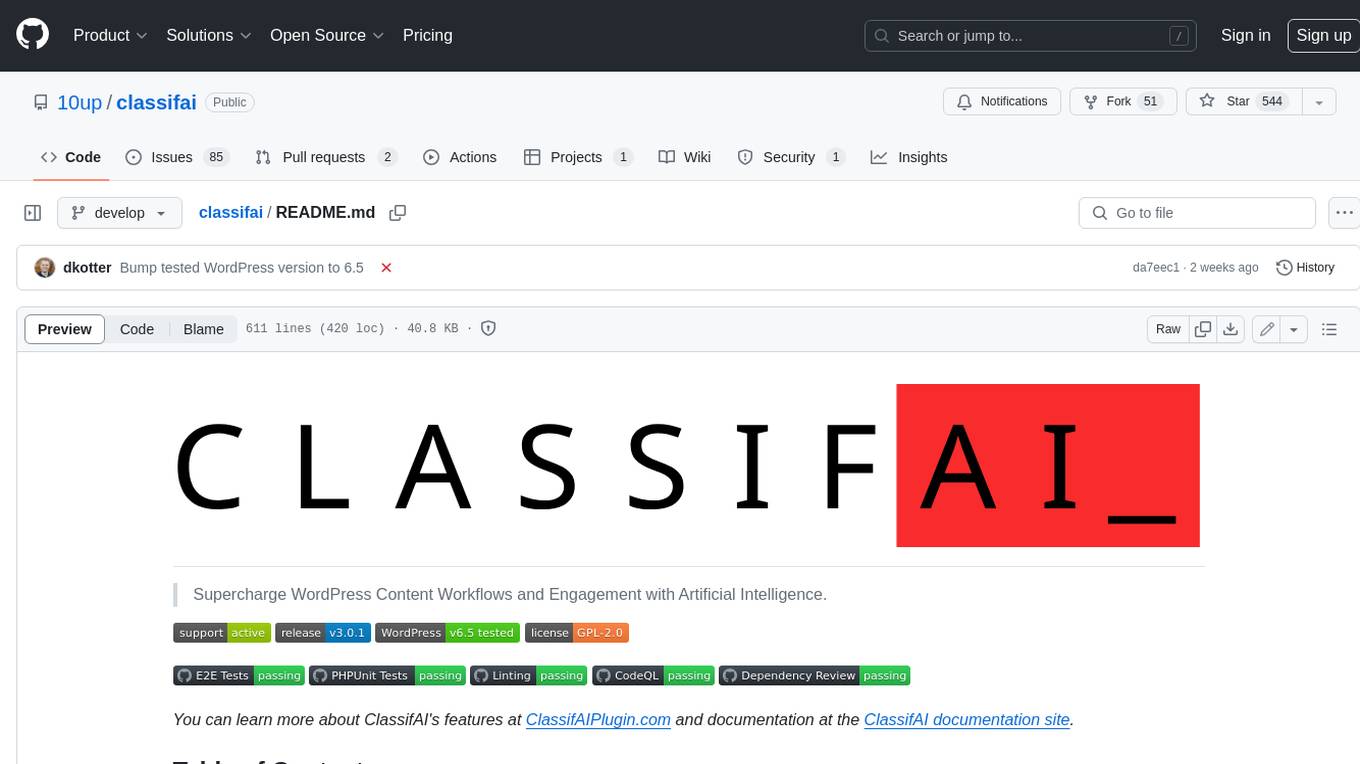
classifai
Supercharge WordPress Content Workflows and Engagement with Artificial Intelligence. Tap into leading cloud-based services like OpenAI, Microsoft Azure AI, Google Gemini and IBM Watson to augment your WordPress-powered websites. Publish content faster while improving SEO performance and increasing audience engagement. ClassifAI integrates Artificial Intelligence and Machine Learning technologies to lighten your workload and eliminate tedious tasks, giving you more time to create original content that matters.

chatbot-ui
Chatbot UI is an open-source AI chat app that allows users to create and deploy their own AI chatbots. It is easy to use and can be customized to fit any need. Chatbot UI is perfect for businesses, developers, and anyone who wants to create a chatbot.

BricksLLM
BricksLLM is a cloud native AI gateway written in Go. Currently, it provides native support for OpenAI, Anthropic, Azure OpenAI and vLLM. BricksLLM aims to provide enterprise level infrastructure that can power any LLM production use cases. Here are some use cases for BricksLLM: * Set LLM usage limits for users on different pricing tiers * Track LLM usage on a per user and per organization basis * Block or redact requests containing PIIs * Improve LLM reliability with failovers, retries and caching * Distribute API keys with rate limits and cost limits for internal development/production use cases * Distribute API keys with rate limits and cost limits for students

uAgents
uAgents is a Python library developed by Fetch.ai that allows for the creation of autonomous AI agents. These agents can perform various tasks on a schedule or take action on various events. uAgents are easy to create and manage, and they are connected to a fast-growing network of other uAgents. They are also secure, with cryptographically secured messages and wallets.

griptape
Griptape is a modular Python framework for building AI-powered applications that securely connect to your enterprise data and APIs. It offers developers the ability to maintain control and flexibility at every step. Griptape's core components include Structures (Agents, Pipelines, and Workflows), Tasks, Tools, Memory (Conversation Memory, Task Memory, and Meta Memory), Drivers (Prompt and Embedding Drivers, Vector Store Drivers, Image Generation Drivers, Image Query Drivers, SQL Drivers, Web Scraper Drivers, and Conversation Memory Drivers), Engines (Query Engines, Extraction Engines, Summary Engines, Image Generation Engines, and Image Query Engines), and additional components (Rulesets, Loaders, Artifacts, Chunkers, and Tokenizers). Griptape enables developers to create AI-powered applications with ease and efficiency.



